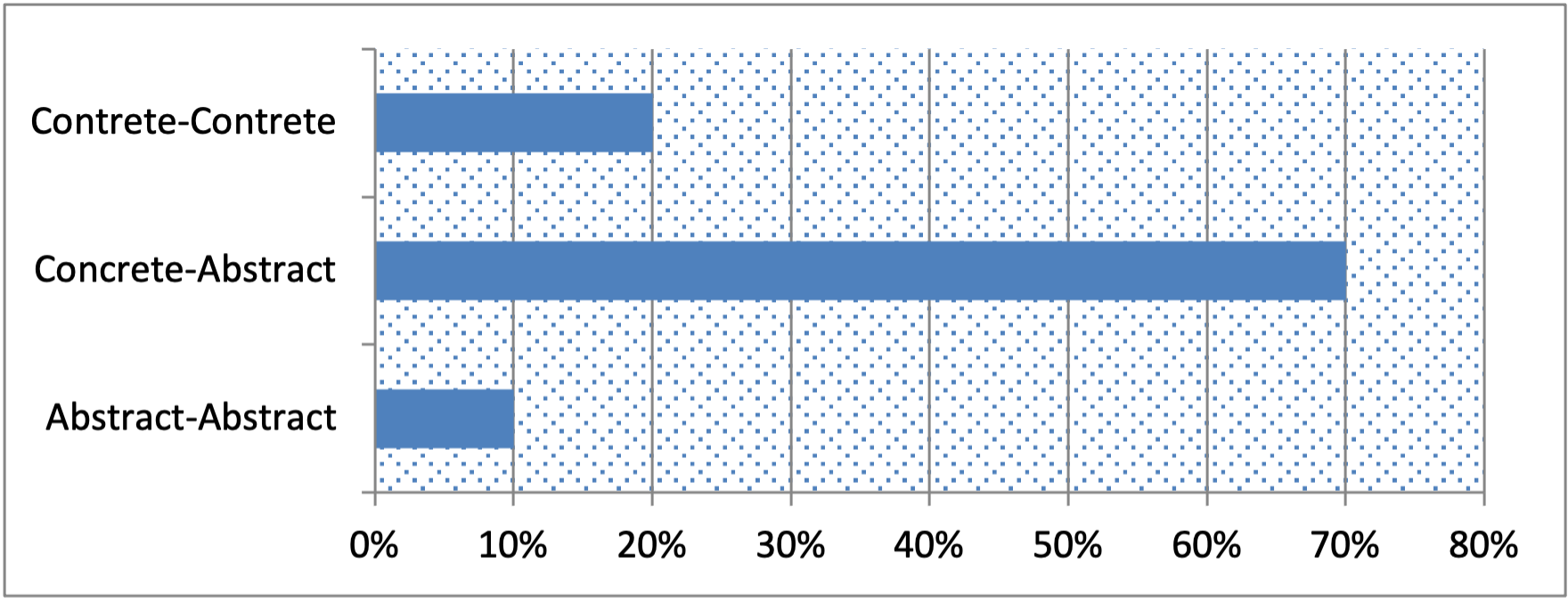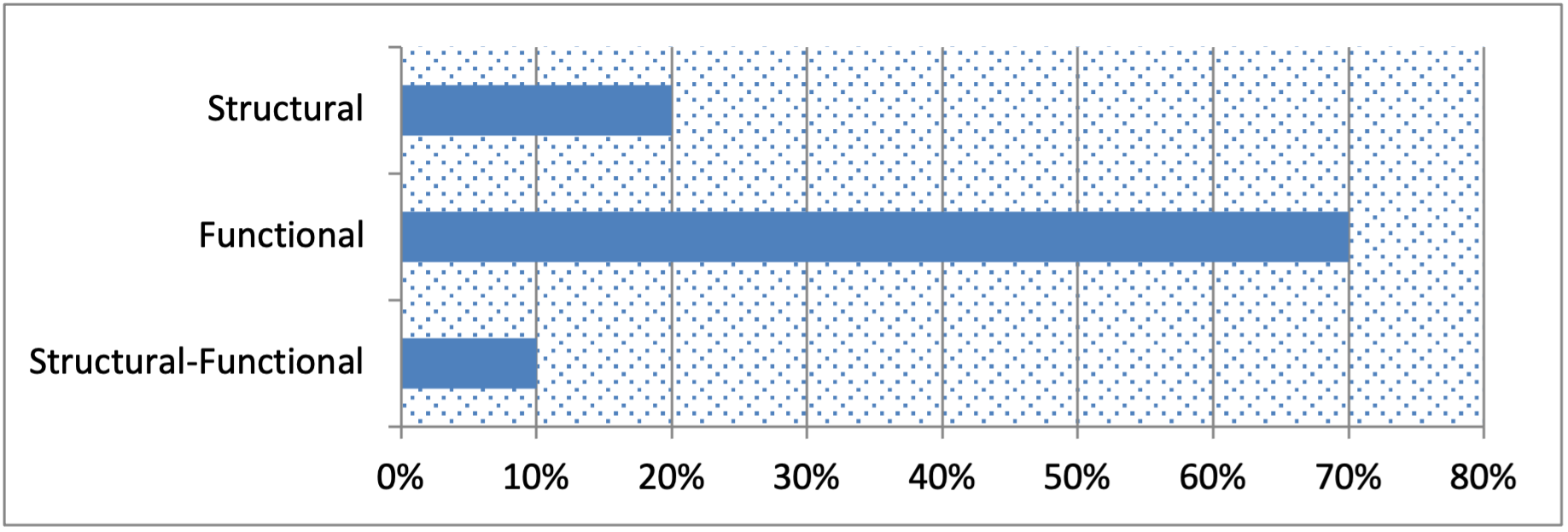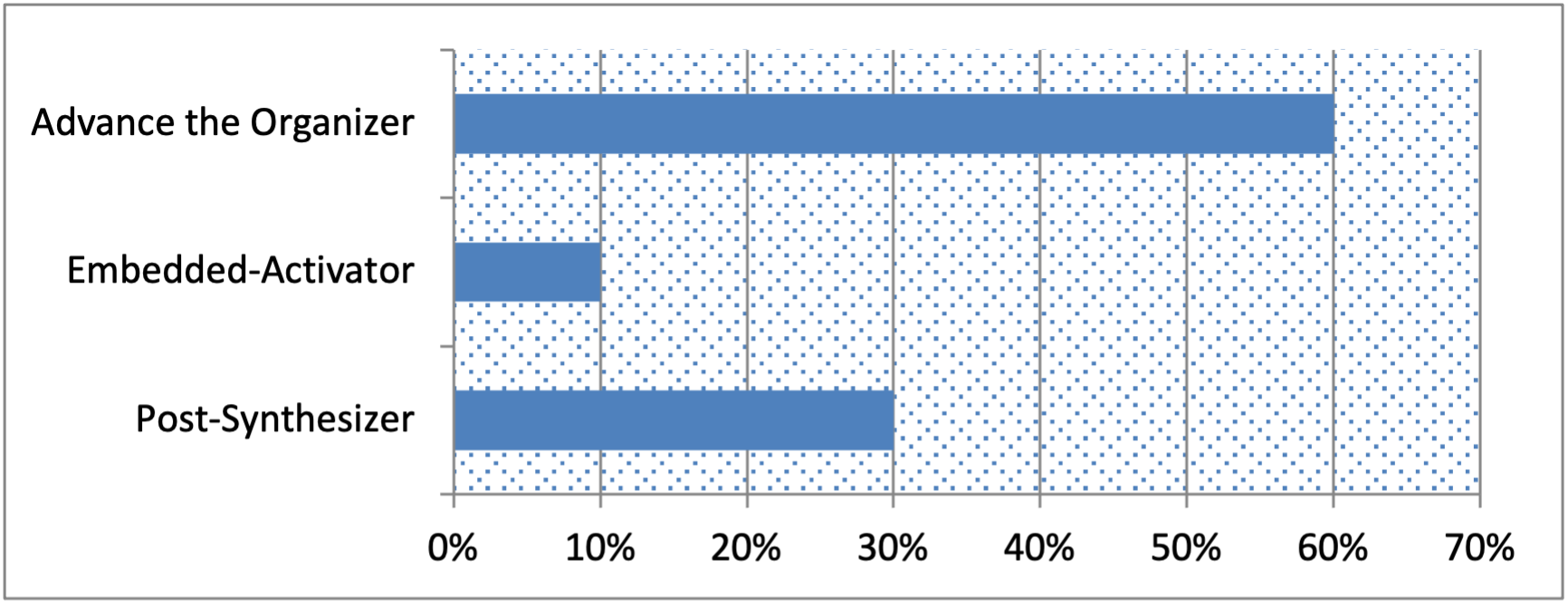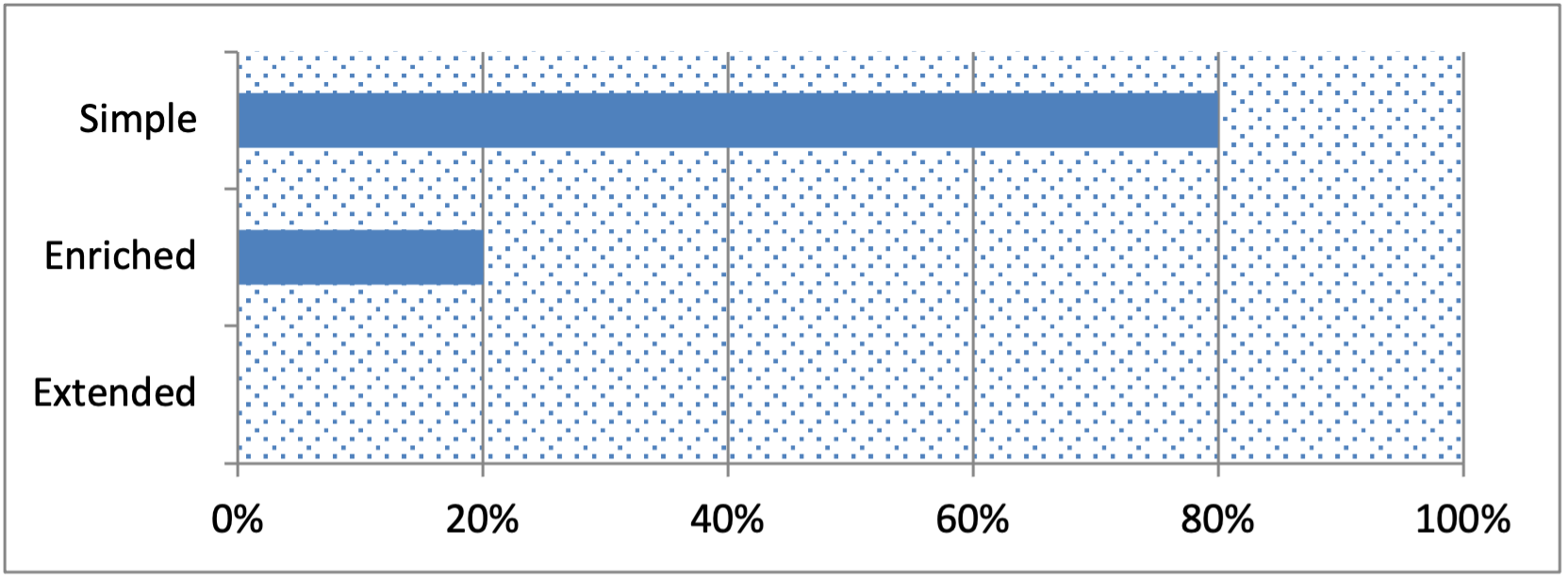Asia-Pacific Forum on Science Learning and Teaching, Volume 20, Issue 2, Article 1 (Jun., 2021) |
Findings of the two research questions are presented here sequentially and discussed to serve the purpose of this study with the support of relevant literature.
Teachers’ views
Teachers’ views were collected through both questionnaire and interviews. The interviews were conducted to explain or elaborate on the data collected through questionnaire. This portion presented as two themes which are teachers’ belief and teachers’ understanding.
Teachers’ belief: Statement 1, 2 and 3 of the survey questionnaire represent teachers’ belief about their own teaching regarding analogy.
Table VI. Teachers’ belief about their own teaching regarding analogy
Statement
SD
D
UN
A
SA
Mean Score
Indication of Mean
1. During physics lessons, I sometimes use analogies consciously
0
0
0
33
22
4.4
Teachers have claimed that they sometimes use analogies consciously during Physics lessons.
2. More frequently I use analogies consciously rather than when they arise spontaneously
0
2
1
32
20
4.27
Teachers have agreed that they use analogies consciously rather than they arise spontaneously.
3. I encourage students to analyze analogies contained in textbooks
1
1
0
34
19
4.25
Teachers have agreed that they encourage their students to analyze analogies from the textbooks.
N.B: SD- Strongly Disagree, D- Disagree, UN- Uncertain, A- Agree, SA- Strongly Agree
The results represent that all the teachers (100%) claimed that they use analogies during physics teaching learning. Almost all (94.6%) of the teachers use analogies consciously rather than they arises spontaneously and encourage (94.5%) their students to analyze analogies contained in textbook.
Statement 13 and 16 represented teachers’ belief about the effects of analogy on students.
Table VII. Teachers belief of the effect of analogies on students
Statement
SD
D
UN
A
SA
Mean
ScoreIndication of Mean
13. If the teacher uses analogy in an explanation, the students reiterate it in their answers or discussions
1
6
5
40
3
3.69
Teachers have agreed that if they use analogy during teaching learning, students use it in their answer scripts too.
16. At the end of secondary education, most students have sufficiently developed analogical reasoning
0
2
3
37
13
4.11
Teachers agreed that most students develop the analogical reasoning skill by the end of their secondary education.
N.B: SD- Strongly Disagree, D- Disagree, UN- Uncertain, A- Agree, SA- Strongly Agree
Majority (78.2%) of the respondents agreed that students reiterate the analogy they learn in the classroom in their answers during a test. Majority (91%) of the respondents agreed that most students sufficiently develop analogical reasoning at the end of secondary education.
Participant teachers have positive belief about their own teaching regarding analogy. They think that they use analogies consciously and they encourage their students to analyze analogies contained in textbooks. Teachers’ belief on the effect of analogy on students is positive but they think that students reiterate the analogies used in the classroom in their tests. Teachers also think that using analogy is more suitable for Bangladesh as we have lack of instruments and other teaching aids and also financial constrain in educational sector. We have time constrain and the number of students is also high and it creates difficulty in conducting inquiry-based teaching in science class.
Brown and Salter (2010) suggest that it is extremely important that due caution be exercised to be sure that students remember the content and not just the analogy. In Bangladesh, on average about 15% schools and 31% madrasahs have no science laboratory (though there is a small store of a little amount of equipment in a self or in a drawer of head master’s / principal’s room or in teachers room). 13.5% rural and 20.3% urban high schools and 23.1% and 13.6% urban madrasahs purchase equipment regularly. More than 50% schools and Madrasahs have no provision for annual budget for laboratory fund (BANBEIS, 2015). Due to this situation, using analogy is more preferable for science teaching in Bangladesh.
Teachers’ understanding: Statement 4, 5, 6, 7, 8, 9, 10, 11, 12, 14 and 15 referred to teachers understanding on the effectiveness of analogy.
Table VIII. Teachers’ understanding on the effectiveness of analogy
Statement
SD
D
UN
A
SA
Mean Score
Indication of Mean
4. I think that analogies help students to imagine and understand directly perceived objects or processes
7
13
2
20
13
2.65
Teachers’ view about this item is uncertain. Some think that analogies help students to understand objects or processes even if it can be perceived directly while others have a total opposite point of view. Due to the variety of perspectives, teachers’ view is uncertain.
5. I think that analogy contributes to development of imagination
0
2
0
19
34
4.55
Teachers have strongly agreed that analogy contributes to the development of imagination of the students.
6. I think that analogy contributes to understanding of abstract concepts
0
1
0
37
17
4.27
Teachers have agreed that analogy contributes to understand abstract concepts.
8. Analogy sometimes diverts attention from the main concept which misleads students
10
19
11
12
3
2.62
Teachers’ view about this item cannot be generalized. They have various perspectives and as a whole, their thinking about the negative feature of analogy is uncertain. They are not sure if analogy can mislead students or not.
N.B: SD- Strongly Disagree, D- Disagree, UN- Uncertain, A- Agree, SA- Strongly Agree
Only one third (36.3%) of the respondents think using analogy won’t be effective when students get the chance of direct experience. Almost all (96.3%) of the respondents think analogies can develop imagination among students. 98.2% respondents think that analogy contributes to understanding of abstract concepts. Only 27.3% respondents think that analogy can mislead students and 20% are uncertain about it.
Statement 7, 9, 10, 11, 12, 14 and 15 referred to the understanding of teachers about how to use analogy.
Table IX. Teachers’ understanding on using analogy
Statement
SD
D
UN
A
SA
Mean Score
Indication of Mean
7. Even if the analogue is unfamiliar to the learners, using analogy can be effective for teaching learning
6
16
1
30
2
2.89
Teachers are uncertain about the fact that if the analogue used during using analogy should be familiar to the students or not.
9. Using analogies do not require information about students’ prior knowledge
7
28
0
19
1
3.38
Teachers are uncertain if students’ prior knowledge should be explored before using analogy or not.
10. Analogy is effective without drawing similarities and dissimilarities between analogue and target
5
27
5
15
2
3.27
Teachers are uncertain if drawing similarities and dissimilarities between analogue and target should be drawn or not during using analogies.
11. Visualization of analogy is more effective than just the process of negotiation
7
21
8
16
2
2.67
Teachers are uncertain if visualization of analogy is more effective than just negotiation process.
12. When the teacher provides verbal analogy in class, the students are left to work out comparisons and conclusions about the target
4
16
3
25
7
3.27
Teachers are uncertain about the fact if only verbal analogy is sufficient for students or not.
14. Purposeful use of analogies develops the ability to apply knowledge to new situations, develops transfer skills
4
10
7
19
15
3.56
Teachers have agreed that purposeful use of analogies develops students’ ability to apply knowledge to new situations.
15. Learning with analogies requires a mental “leap” because it involves imagining one thing as another
3
12
3
27
10
3.53
Teachers agreed that students need a mental leap for learning with analogies.
N.B: SD- Strongly Disagree, D- Disagree, UN- Uncertain, A- Agree, SA- Strongly Agree
Only 40% of the respondents think that analogue need to be familiar to the students for analogy to be effective in teaching learning while others think there is no need of using analogues familiar to the students. More than half (63.7%) of the respondents think that there is no need of students’ prior knowledge exploration before using analogy and 58.2% think that analogies can be effective even without drawing similarities and dissimilarities between analogue and target. Only 32.7% respondents think that visualization of analogy is more effective than just the process of negotiation while 14.5% are uncertain about this. 58.2% respondents think that students are left to work out comparisons and conclusions about the target if it is presented only verbally. Purposeful use of analogies is thought as effective to develop the ability to apply knowledge to new situations and to develop transfer skills by more than half (61.8%) of the respondents. 67.3% respondents agreed that students need a mental leap for learning with analogies.
Teachers have just a little idea about this pedagogy and not confident about using it in teaching learning. From interview, it was found that they have no guideline of using analogies and they are not aware about using it. They use it unsystematically. Teachers need to be informed about the effectiveness of analogy so that they can use it effectively more often during teaching-learning. The main sources of teachers’ used analogies are textbook, internet and natural environment and they think they need more sources for ensuring quality teaching.
The mean values of each statement delineate a better understanding of teachers view about the statements. Total mean of these 16 items is 3.6 which indicates that teachers have some idea but do not have sufficient knowledge about analogy. Analogies’ positive and negative features are not clear to them and they are uncertain about some vital items related to analogy. They have a little experience with analogies and they are not confident about this pedagogy.
According to Treagust and Duit (2012), science teachers can use analogies more effectively through a carefully planned strategy. The conclusion by Cruz-Hastenreiter (2015) suggests that during teaching learning activities the use of analogies can be planned to promote analogical reasoning. From the study of Jonane (2015), it is found that ‘purposeful use of analogy develops students’ ability to apply knowledge to new situations and assist development of transfer skills.’ Duit and Glynn (1996) have said that analogies are ‘double edged swords’ as it can create misconception. Treagust and Duit (2012) claimed that attributes that are not similar between analogy and the target often cause misunderstanding. Research has shown that it is essential for teachers to ensure that their explanations using models are student friendly and compatible with students’ existing knowledge. Exploring students’ prior knowledge and daily life experience is considered as helpful for students to understand the unfamiliar and abstract concept by Halder and Rahman (2015, p.57).
Researchers suggest that analogy acts as an effective pedagogical approach which needs to be presented systematically for avoiding its negative features. There are several models of using analogy such as FAR guide, TWA model, WWA model and GMAT model. Teachers need to follow any recommended model for using analogy according to their choice or comfort. Teachers need training on how to use analogy and need to be informed about models of using it. Jonane (2015) claimed that famous analogies in science frequently reveal an ability to make mental leap, so teachers need a good source of analogies to get access to famous analogies easily.
*The FAR (Focus-Action-Reflection) guide is recommended by Curtis & Reigeluth (1984)
*Teaching-with-Analogies (TWA) model is developed by Glynn (1991)
*Working with Analogies model is suggested by Nashon (2000)
*General Model for Analogy Teaching is provided by Zeitoun (1984)From the above discussion, we can say that, using analogy need to be systematic and planned before using it in the classroom. Analogies need to be used to understand difficult and abstract concepts and to reduce the problem of misleading. Uncritical use of analogies need to be avoided. Suitable analogy is must in this regard. Prior knowledge exploration of students is necessary before using analogy and drawing similarities and dissimilarities is crucial. Mental leap of students is a must for learning with analogies and analogy itself can develop imagination among students, but it must be used purposefully. Teachers need a good source of analogies with famous and effective analogies as previous researches suggest that famous analogies have positive effect on students.
Teachers’ practices
Case studies were conducted to examine teachers’ practices. Lesson observations (9 lessons) of three teachers and analyzing students’ classwork copies (3 from each case) were combined together to understand teachers’ practices.
Table X. Teachers’ understanding on using analogy
Lesson No
Analogue
Target
1
Tailorbird, their baby and their function around the nest
Structure of atom (nuclease, electron, proton, neutron)
2
Flow of water
Heat transfer
3
Traditional fishing gear (Horga)
Capacitor
4
Pushing students during assembly
Movement of sound wave
5
Bald head, satellite dish
Concave and convex mirror
6
Flow of heat
Current flow (I) ∝ Potential difference (V)
7
Football and goalpost bar
Sound wave forming echo
8
Thread wheel
Structure of solenoid
9
Flow of water from water tank
Difference between static and current electricity
Table XI. Analogues and targets of analogies from document analysis
Analysis
Analogue
Target
1
Prayer beads
Direction of current flow
Total classification of analogies from lesson observation and document analysis is given below.
Here are nine analogies from nine lesson observations and one from document analysis which are categorized into different types on the basis of five categories. The types of analogies according to these categories are given below.
Table XII. Classification of analogy from lesson observations
Lesson
Relationship
Presentation
Abstraction
Position
Enrichment
1st
Structural-functional
Verbal
Concrete-abstract
Embedded-activator
Enriched
2nd
Functional
Pictorial-verbal
Concrete-abstract
Advance the organizer
Simple
3rd
Functional
Verbal
Concrete-abstract
Advance the organizer
Enriched
4th
Functional
Verbal
Concrete-abstract
Post-synthesizer
Simple
5th
Structural
Pictorial-verbal
Concrete-concrete
Post-synthesizer
Simple
6th
Functional
Verbal
Abstract-abstract
Advance the organizer
Simple
7th
Functional
Pictorial-verbal
Concrete-abstract
Advance the organizer
Simple
8th
Structural
Verbal
Concrete-concrete
Advance the organizer
Simple
9th
Functional
Verbal
Concrete-abstract
Advance the organizer
Simple
Table XIII. Classification of analogy from document analysis
Analysis
Relationship
Presentation
Abstraction
Position
Enrichment
Analysis 1
Functional
Verbal
Concrete-abstract
Post-synthesizer
Simple
Graphical representations of classified analogies are given below.
Total 10 analogies form lesson observation and document analysis were analyzed through five categories. The graphical representations of these categories are presented here:
Figure 1. The analogical relationship between analogue and target
Mostly functional similarity (70%) was drawn between analogue and target, some were of structural similarity (20%) and only 10% were of structural and functional both similarities.
Curtis and Reigeluth (1984) stated that a purely structural analogy focuses on a unique similarity between an analogue and a target but the number of differences between an analogue and a target is also high. According to them, functional analogies tend to be used to teach complex and abstract subjects. Curtis and Reigeluth (1984) suggested to use structural-functional analogies as they are more comprehensive and more powerful in terms of expression.
The recommendation for analogical relationship during using analogy is
Structural-Functional > Functional > Structural

Figure 2. The presentational format
Majority of the analogies were verbally (70%) presented, others were presented both pictorially and verbally (30%).
According to Treagust and Duit (2012), if teachers provide verbal analogies, the students are left to compare and conclude about the target from the description of analogy on their own. Pictorial analogies can highlight more of the desired features of the analogy to the students and this visualization can reduce the insufficiency of familiarity with the analogy.
From this statement, we can say that pictorial-verbal analogies are more effective than only verbal analogies. From observation and document analysis, it is found that most analogies were used verbally. This should be changed and more pictorial-verbal analogies need to be included. But from the studies of Treagust, Duit, Joslin & Lindauer (1992); Dagher (1995); Venville and Treagust (1996) and Sizmur and Ashby (1997), it is found that the presentation of analogies is mainly through verbal descriptions (cited in Ramos, 2010). Curtis and Reigeluth (1984) stated that verbal presentation format may be sufficient for teaching analogical relationships but pictorial-verbal format is preferable for students at lower level.
The recommendation for presentation format is
Pictorial-Verbal > Verbal

Figure 3. The level of abstraction of the analogue and target concepts
Analogues were mostly concrete and targets were abstract. In 70% cases, analogues were concrete and targets were abstract. On the other hand, in 20% cases analogues were concrete and targets were abstract. Only in 10% cases both analogues and targets were abstract.
Concrete analogies facilitate understanding of abstract concepts by pointing to similarities between objects or events in the students’ world and the phenomenon under discussion (Aubusson, Treagust & Harrison, 2009). This means that analogues should not be abstract.
The recommended level of abstraction for analogues is
Concrete > Abstract
Figure 4. The position of the analogue relative to the target
In more than half of the cases (60%), analogues were presented before targets (advance the organizer). In some classes (30%) targets were presented before analogues (post-synthesizer). Only in 10% cases, targets were presented along with analogues (embedded-activator).
Curtis and Reigeluth (1984) and Newton (2003) mostly found Advance the Organizer and Embedded-Activator analogies through their studies and these are better than Post-Synthesizer.
The recommended position of the analogue and target is
Advance the Organizer / Embedded-Activator > Post-Synthesizer
Figure 5. The level of enrichment
80% used analogies were simple and only 20% were enriched. No extended analogies were found.
Harrison and Treagust (2006) recommended that the recognition and mapping problems can be reduced if teacher explicitly alert students to the analogical conditions, which means they suggested using enriched analogies over simple ones. The research studies of Glynn and Takahashi (1998) found that in an extended analogy, analogue features are systematically mapped onto the target features and verbal and imaginary process are also active. Another study of Carey’s (cited in Harrison & Treagust, 2006) claims that extended analogy promotes deep thinking and conceptual understanding. According Akcay (2016), misunderstandings or misinterpretations can be avoided by enriched analogies through providing details on the extent and limitations of specific analogies. The above discussion represents that simple analogy may generate alternative conception or confusion among students so it is better to use enriched and extended analogies with analogical conditions.
The recommended level of enrichment for analogies is
Extended / Enriched analogies > Simple analogies
In our country, simple analogies are mostly used and presented verbally. In most cases, functional relationship between analogue and target is established. Analogues are mostly presented before targets. Most of the used analogues are concrete. We can say that, the types of analogy used and their presentation format is not up to the mark.
From literature, preferable analogies are of enriched or extended types and it is better to present through both verbally and pictorially. Analogues need to be presented before or along with targets and should be of concrete in nature. Functional or structural-functional analogies are preferred over only structural analogies.
Implications
This study can inform our science teachers about the importance of this pedagogy. It has the potential to motivate them to use analogy more often during teaching learning and avoid the negative features. Teachers can include more analogical items in tests to develop mental leap among students. This study will be beneficial for the school authorities as it finds that teachers face problem due to high workload and time constraint. The findings of this study can inform the educators about the negative impacts of using this pedagogy without any structured model and inspire them to provide guideline for teachers through in-service and professional teacher trainings. The effectiveness of purposeful use of analogies can influence our educators to include it in our curriculum as a pedagogical approach. This study explores types of analogies which are effective. Textbook writers can follow this study to include suitable analogies for abstract and complex targets.
There are many scopes to conduct researches on this pedagogy as it is quite new in our country. Analyzing the types of analogies in our existing science textbooks, recognizing the effective ones and the ones that may induce misconception demand urgent concerns. This study only included secondary level physics teachers. Further research on secondary chemistry, biology teachers or teachers of primary or junior secondary level can be conducted.



